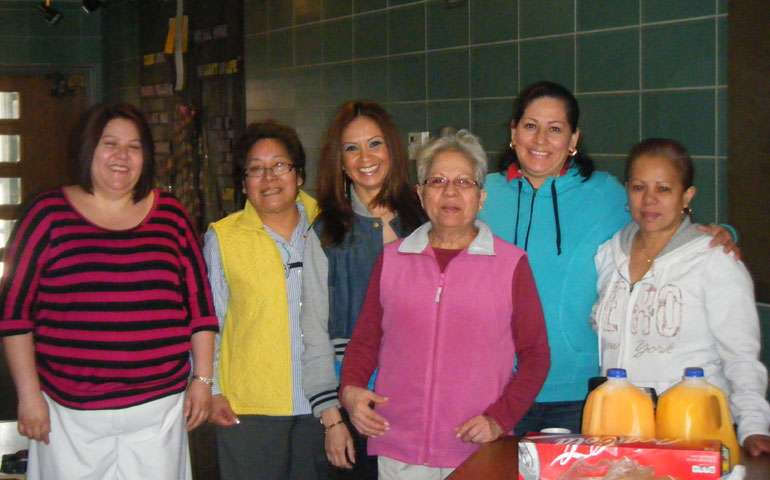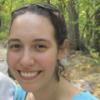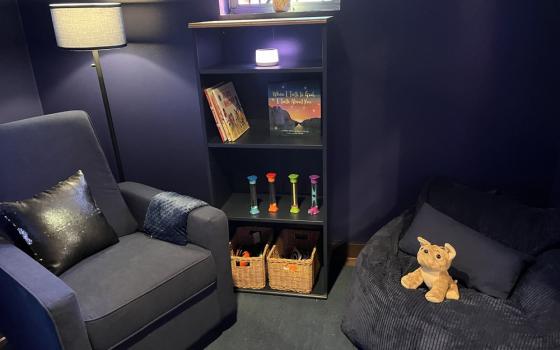
From left: Soledad Díaz, Paula Barragan, María Olivo, Amada Pérez, Jaqui Moreno and Luz Rodriguez at their last English as a second language group meeting of the year April 27 (Julie Drew)
Before Julie Drew retired from 25 years of teaching at Washington Elementary School in Evanston, Ill., she lived abroad multiple times and knows what it is like to feel like "the other." This has led her to want to help members of St. Nicholas Parish in Evanston who are not originally from the U.S. feel that the church belongs to them, instead of feeling they are merely visitors.
After getting the go-ahead from the pastor, Fr. William Tkachuk, Drew started a program for English as a second language in September 2010. Mothers drop off their children for religious education classes on Saturday mornings and Drew teaches them English while they wait for their children.
|
This poem was written by members of the English as a second language class at St. Nicholas Parish in Evanston, Ill. Each member contributed images based on her memories of her first Communion. |
|
My First Communion Preparing with Madrina Processing in white Rosary, prayerbook -- Angela Reynosa, Amada Pérez, Julie Drew, Jaqui Moreno, Giseh Moreno, Soledad Díaz, Jane Whitford and María Olivo |
Though the women's schedules may vary, six to eight consistently show up to practice reading, writing and speaking in English.
Evanston, located north of Chicago, has a population of 74,785 according to the latest U.S. Census. About 17 percent of the population is foreign-born, according to the census, but about 25-30 percent of parishioners at St. Nicholas Parish are immigrants, according to Tkachuk. Most come to Evanston looking for jobs and affordable housing, he said.
Drew uses a model of teaching she used when she lived in Florence, Italy, in 1981 and 1986 and taught English to the Italian employees of the U.S. Consulate. She covers language, the ability to speak and to understand, as well as literacy, being comfortable with reading, and "how to be an aware and joyful reader."
The flexible format, she said, allows her to "respond to the needs or desires of who I'm with."
"I was just always interested in bilingual education," Drew said. She even got her ESL certification so she could be a part-time teacher with Oakton Community College classes held at Evanston Township High School.
Though she does not live within the boundaries of the parish, she chose St. Nicholas 25 years ago because it was addressing the same issues she was encountering in her teaching.
"How do you make a home that is home for everybody, where nobody is 'the other,' nobody's the interloper … so that everyone has ownership of things?" Drew asked.
Amada Pérez, originally from El Salvador, is the leader of the Bible study component of the ESL program. The group meets every fourth Saturday of the month.
Pérez's background is in adult religious education, but she attends the group every Saturday to learn English, too.
The United States "is a country where English is spoken and it is good to know another language to be able to relate with everyone else who speaks English," Pérez said.
Group members recently wrote a poem about memories of first Communions. Drew, a member of the Chicago Area Writing Project and a poetry lover, wanted to try a fun exercise.
"There is a technique [from the project] for writing group poems, where everybody contributes an image," she said. What she ran into, however, was that instead of a line or an image, the women wrote whole paragraphs.
"I then asked them to go back and start with a participle … and choose one thing that they really liked about their poem," Drew said.
After shortening their answers, the group then arranged them into three categories: preparation, liturgy and celebration.
"It was very nice because we start to remember the traditions of our countries," Pérez said.
The ESL program also allows the women to make other connections. Some are avid knitters, which led Drew to introduce them to the St. Nick's Knitters group she was also a part of. As the women began to donate their works to the annual church fair, Drew saw that the ESL program had the potential to build a bridge between the Anglo and Latino communities.
"As much as we try, there really are two communities and it's just really hard to bridge that," she said.
During Lent, the ESL program adds a Bible study component. Reading the Scriptures in Spanish draws more people to the group for the prayer part, though not necessarily the language part.
At the end of the first year, when Drew was evaluating the program and asking for suggestions, one woman suggested reading a book. Drew remembered that books by Francisco Jiménez that she had used in her classes had wonderful stories. The author was a child migrant worker who, after a number of trials in his life, now is a professor in California. Drew began teaching from the book the second year.
The reading of the Jiménez books continued into this year, the third year, because some group members wanted to continue on with the second book while new members came and wanted to read the first.
Laura Vargas, originally from Mexico, was so eager to read the third book by Jiménez that she met with Drew for coffee throughout the summer to finish it.
Vargas first began participating in the ESL program when her son started his first Communion and confirmation classes. She went consistently for a year and a half and only recently has had to stop going as often due to scheduling conflicts.
"I would take him [to his class] and I would make the most of my time … mainly learning how to write [English]," Vargas said. "I may not speak it very well, but I can speak it, but writing it is a lot of work."
Since Vargas has read all three Jiménez books, Drew will sometimes ask her to help the women who are just starting out with the first or second book. While Drew goes over the third book, Vargas will read the first or second to the women before joining Drew for discussion. "We get together and Julie starts to ask questions about certain words or something they might not have understood about the book we are reading," Vargas said.
She says Drew is flexible with the ESL program in that she opens it up to other people. If someone comes wanting to share information like how to better educate and understand their children, Drew makes room for them to share that in the group.
In addition to the language component, there is Pérez's Bible study group and the group that meets during Lent.
"I like it very much because the people are interested in knowing … when they need faith, hope, that is where they can find that," Pérez said.
As much as the women enjoy learning with Drew, she finds her time with them just as fulfilling, if not more.
"It's probably my favorite time of the week," she said. "It's something I love to do and I'm in a place where I can do it. It just feels like the best of life."
[Eloísa Pérez-Lozano is an NCR Bertelsen intern. Her email address is eloisapl@ncronline.org.]


